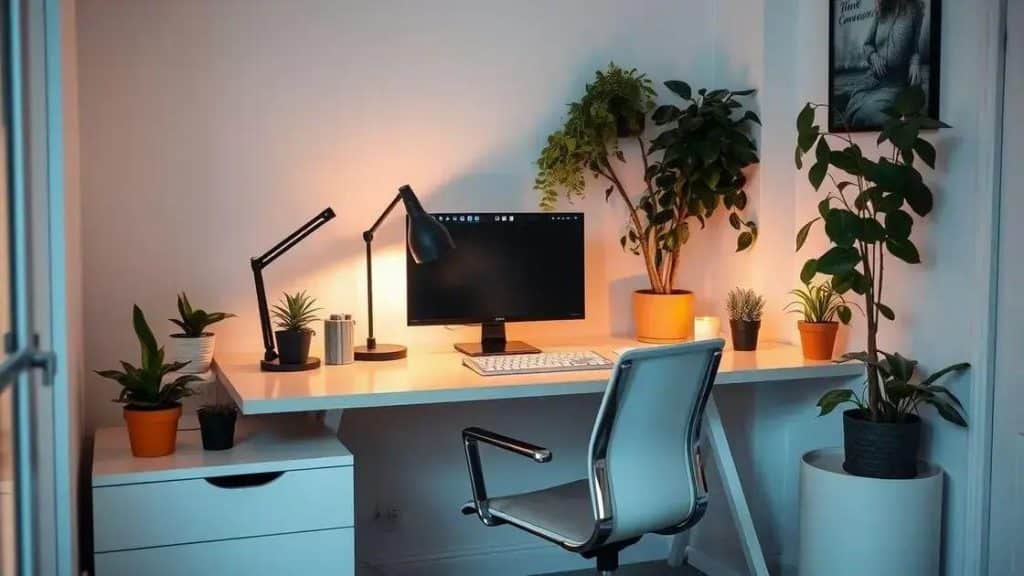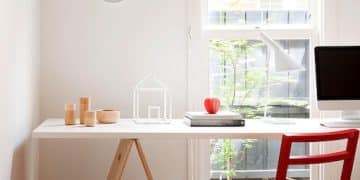Ergonomic desk setup for small apartments: maximize comfort

An ergonomic desk setup for small apartments involves selecting supportive furniture, maintaining good posture, using essential accessories, and organizing your workspace effectively to enhance comfort and productivity.
Looking for an ergonomic desk setup for small apartments? You’re not alone. Many of us are trying to balance comfort and functionality in limited spaces. Let’s dive into practical solutions that can enhance your work experience.
Choosing the right furniture for small spaces
When it comes to setting up an ergonomic desk setup for small apartments, choosing the right furniture is essential. The right pieces not only fit your space but also enhance your comfort and productivity. Let’s explore some key considerations.
Key Features to Look For
Consider furniture that offers both functionality and style. Look for items that are:
- Space-saving: Choose desks that are compact yet functional, like wall-mounted or foldable options.
- Adjustable: Ergonomic chairs or sit-stand desks that can be adjusted for height can help tailor your setup.
- Multi-functional: Use furniture that serves more than one purpose, such as desks with built-in storage.
Avoid bulky desks that occupy too much space. Instead, opt for minimalist designs with clean lines. This not only maximizes your area but creates a more open feel. Desks with shelves can help streamline your workspace, keeping essentials within reach.
Materials and Comfort
The materials used in your furniture can affect comfort and longevity. Examine items that combine aesthetics and durability. Look for:
- Lightweight materials: Wood or metal frames that are easy to move.
- Soft cushioning: Ergonomic chairs with ample padding to support long hours of sitting.
- Easy-to-clean surfaces: Desks with finishes that resist stains and scratches.
Remember, an ergonomic desk setup isn’t complete without considering your seating too. A good chair with lumbar support keeps your posture aligned while you work.
Think about how your setup can evolve. Investing in modular furniture allows you to reconfigure your space when needed. It’s also a great way to add personality to your apartment.
Ultimately, the right furniture can create a workspace that not only fits but enhances your daily routine.
Essential accessories for an ergonomic workspace

Creating an ergonomic workspace goes beyond just selecting the right desk and chair. The right accessories can make a significant difference in your comfort and productivity throughout the day. Let’s explore some essential accessories that can enhance your overall setup.
Key Accessories
Investing in the right tools can lead to a better work experience. Here are a few must-have items:
- Keyboard and mouse: Ergonomic keyboards and mice are designed to reduce strain on your hands and wrists. They help maintain a natural position while you work.
- Monitor stands: Raising your monitor to eye level helps prevent neck strain. Adjustable stands can also create space underneath for additional storage.
- Desk organizers: Keeping your workspace tidy is essential. Use organizers to store pens, papers, and other supplies to minimize clutter.
Another great accessory to consider is a mouse pad with wrist support. This addition can greatly improve your comfort while using a computer for long periods. A footrest is also a good idea, especially if your feet do not touch the ground when sitting. This helps in maintaining proper posture.
Lighting and Sound
Good lighting is critical in any workspace. Natural light is the best option, but desk lamps with adjustable brightness can help reduce eye strain, especially during late hours. Position your light source behind you to avoid glare on your screen.
Incorporating sound-absorbing materials can also be beneficial. If you work in a noisy environment, consider adding soft furnishings such as rugs or curtains to dampen noise. Using a white noise machine can help create a more focused atmosphere.
Finally, personalization is key. Adding personal touches, like a plant or artwork, can boost your mood and make your workspace feel more inviting. Finding the right balance between functionality and aesthetics will enhance both your productivity and comfort.
Tips for organizing a compact desk area
Organizing a compact desk area is crucial for maximizing both space and efficiency. A well-organized workspace can help you stay focused and productive. Here are some practical tips to help you achieve the best setup.
Declutter Regularly
Start by removing unnecessary items from your desk. Keep only the essentials within reach. This not only creates a cleaner look but also helps you find what you need quickly. Consider digitizing paper documents to free up even more space.
Utilize Vertical Space
Make use of vertical storage options such as shelves. Installing floating shelves can free up desk space while providing extra room for books and supplies. Use wall organizers or pegboards to display items like pens and notepads. This keeps your essentials at eye level and easily accessible.
Incorporate Multi-functional Furniture
Choose pieces of furniture that serve multiple purposes. For example, a desk with built-in storage compartments can help keep essentials out of sight. You may also consider a desk that can be folded away when not in use. This flexibility can maximize your space significantly.
Keep your work area tidy by using drawer organizers or desktop trays. These help you categorize supplies, making it easier to find what you need without digging through piles.
Maintain a Minimalist Aesthetic
Embrace a minimalist design by limiting the number of decorative items on your desk. A few well-placed accents can add personality without creating clutter. Choose a color scheme that is calm and cohesive. This can create an inviting atmosphere conducive to work.
Lastly, personalize your workspace with a few items that inspire you, like a small plant or a photo. This makes the space your own without overcrowding it.
Maintaining posture and comfort while working

Maintaining good posture is essential for comfort while working, especially in an ergonomic desk setup for small apartments. Good posture can prevent strain and injuries, allowing you to work more efficiently. Proper seating is the first step to achieving this.
Choosing the Right Chair
Your office chair should provide adequate support. Look for chairs with adjustable height, lumbar support, and a comfortable design. A chair that encourages an upright position while supporting your lower back helps keep your spine aligned.
Desk Height and Arrangement
The height of your desk also plays a role in maintaining proper posture. Your elbows should be at a 90-degree angle while typing, with wrists straight and hands at or slightly below elbow level. If your desk is too high or low, consider using a keyboard tray or an adjustable desk.
Foot Positioning
Keep your feet flat on the floor or on a footrest. This reduces pressure on your legs and helps promote proper posture. Avoid crossing your legs, as this can lead to poor circulation and strain. A footrest can also help if your chair is too high for your feet to touch the ground comfortably.
Taking regular breaks is crucial for maintaining comfort. Stand up, stretch, or take a short walk every hour. This encourages blood circulation and relieves tension built up from sitting for long periods. Simple exercises like shoulder rolls and neck stretches can be done right at your desk to further enhance comfort.
Finally, consider the placement of your monitor. The top of the screen should be at or just below eye level. This helps keep your neck in a neutral position, avoiding strain. Position the screen at a comfortable distance, usually about an arm’s length away, to reduce eye strain.
In conclusion, maintaining a proper posture and comfort while working is essential for long-term health and productivity. By choosing the right furniture, arranging your workspace thoughtfully, and taking regular breaks, you create an ergonomic environment that supports your well-being. Remember to prioritize your health just as much as your tasks, ensuring you can work efficiently and comfortably.
FAQ – Frequently Asked Questions about Ergonomic Desk Setup
What is an ergonomic workspace?
An ergonomic workspace is designed to reduce strain on the body and enhance comfort, often including adjustable furniture and proper accessories.
How can I improve my posture while working at my desk?
To improve posture, choose a chair with good support, adjust your desk height, and keep your monitor at eye level.
Why are breaks important when working at a desk?
Regular breaks help improve circulation, reduce fatigue, and prevent strain or injury from prolonged sitting.
What accessories enhance an ergonomic desk setup?
Essential accessories include ergonomic keyboards and mice, monitor stands, footrests, and drawer organizers to keep your workspace tidy.





